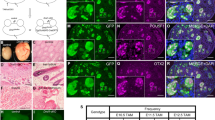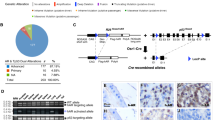Abstract
E2F1 is a crucial downstream effector of the retinoblastoma protein (pRB) pathway. To address the consequences of short-term increase in E2F1 activity in adult tissues, we generated transgenic mice expressing the human E2F1 protein fused to the oestrogen receptor (ER) ligand-binding domain. The expression of the ER-E2F1 fusion protein, which is inactive in the absence of 4-hydroxy tamoxifen (OHT), was targeted to the testes. We show that short-term activation of E2F1 results in activation of E2F target genes and apoptosis of germ cells. Consistent with our previously published results, the apoptotic response was independent of p53. Persistent E2F1 activation for 3 weeks led to massive apoptosis and severe testicular atrophy with seminiferous tubules containing only Sertoli cells and clusters of undifferentiated spermatogonia. The latter showed high expression of ER-E2F1 and excessive mitotic activity, including atypical mitoses. In addition, gonocyte-like dysplastic germ cells, resembling carcinoma in situ (CIS) cells in humans, appeared. Our results show that a relatively short period of deregulated E2F1 activity in testicles can induce premalignant changes. Moreover, we demonstrate the feasibility of tissue-specific expression of conditional ER-E2F1 in transgenic mice.
This is a preview of subscription content, access via your institution
Access options
Subscribe to this journal
Receive 50 print issues and online access
$259.00 per year
only $5.18 per issue
Buy this article
- Purchase on Springer Link
- Instant access to full article PDF
Prices may be subject to local taxes which are calculated during checkout





Similar content being viewed by others
References
Bartkova J, Rajpert-De Meyts E, Skakkebaek NE, Lukas J and Bartek J . (2003). Apmis, 111, 252–265, discussion 265–266.
Cam H and Dynlacht BD . (2003). Cancer Cell, 3, 311–316.
Cartwright P, Muller H, Wagener C, Holm K and Helin K . (1998). Oncogene, 17, 611–623.
Celeste A, Petersen S, Romanienko PJ, Fernandez-Capetillo O, Chen HT, Sedelnikova OA, Reina-San-Martin B, Coppola V, Meffre E, Difilippantonio MJ, Redon C, Pilch DR, Olaru A, Eckhaus M, Camerini-Otero RD, Tessarollo L, Livak F, Manova K, Bonner WM, Nussenzweig MC and Nussenzweig A . (2002). Science, 296, 922–927.
Chaganti RS and Houldsworth J . (2000). Cancer Res., 60, 1475–1482.
Cheville JC, Sebo TJ, Lager DJ, Bostwick DG and Farrow GM . (1998). Am. J. Surg. Pathol., 22, 1361–1367.
Clarke AR, Maandag ER, van Roon M, van der Lugt NM, van der Valk M, Hooper ML, Berns A and te Riele H . (1992). Nature, 359, 328–330.
Clarke AR, Purdie CA, Harrison DJ, Morris RG, Bird CC, Hooper ML and Wyllie AH . (1993). Nature, 362, 849–852.
Conner EA, Lemmer ER, Omori M, Wirth PJ, Factor VM and Thorgeirsson SS . (2000). Oncogene, 19, 5054–5062.
de Bruin A, Maiti B, Jakoi L, Timmers C, Buerki R and Leone G . (2003). J. Biol. Chem., 278, 42041–42049.
de la Cova C, Abril M, Bellosta P, Gallant P and Johnston LA . (2004). Cell, 117, 107–116.
DeGregori J, Kowalik T and Nevins JR . (1995). Mol. Cell. Biol., 15, 4215–4224.
Di Stefano L, Jensen MR and Helin K . (2003). EMBO J., 22, 6289–6298.
Gaubatz S, Wood JG and Livingston DM . (1998). Proc. Natl. Acad. Sci. USA, 95, 9190–9195.
Gautier C, Mehtali M and Lathe R . (1989). Nucleic Acids Res., 17, 8389.
Gavrieli Y, Sherman Y and Ben-Sasson SA . (1992). J. Cell Biol., 119, 493–501.
Hickman ES, Moroni MC and Helin K . (2002). Curr. Opin. Genet. Dev., 12, 60–66.
Holmberg C, Helin K, Sehested M and Karlstrom O . (1998). Oncogene, 17, 143–155.
Hsia KT, Millar MR, King S, Selfridge J, Redhead NJ, Melton DW and Saunders PT . (2003). Development, 130, 369–378.
Hsieh JK, Fredersdorf S, Kouzarides T, Martin K and Lu X . (1997). Genes Dev., 11, 1840–1852.
Humbert PO, Rogers C, Ganiatsas S, Landsberg RL, Trimarchi JM, Dandapani S, Brugnara C, Erdman S, Schrenzel M, Bronson RT and Lees JA . (2000). Mol. Cell, 6, 281–291.
Irwin M, Marin MC, Phillips AC, Seelan RS, Smith DI, Liu W, Flores ER, Tsai KY, Jacks T, Vousden KH and Kaelin Jr WG . (2000). Nature, 407, 645–648.
Jacks T, Fazeli A, Schmitt EM, Bronson RT, Goodell MA and Weinberg RA . (1992). Nature, 359, 295–300.
Johnson DG, Schwarz JK, Cress WD and Nevins JR . (1993). Nature, 365, 349–352.
Lee EY, Chang CY, Hu N, Wang YC, Lai CC, Herrup K, Lee WH and Bradley A . (1992). Nature, 359, 288–294.
Lindeman GJ, Dagnino L, Gaubatz S, Xu Y, Bronson RT, Warren HB and Livingston DM . (1998). Genes Dev., 12, 1092–1098.
Littlewood TD, Hancock DC, Danielian PS, Parker MG and Evan GI . (1995). Nucleic Acids Res., 23, 1686–1690.
Lomazzi M, Moroni MC, Jensen MR, Frittoli E and Helin K . (2002). Nat Genet, 31, 190–194.
Lukas J, Petersen BO, Holm K, Bartek J and Helin K . (1996). Mol. Cell. Biol., 16, 1047–1057.
Mehtali M, LeMeur M and Lathe R . (1990). Gene, 91, 179–184.
Meng X, Lindahl M, Hyvonen ME, Parvinen M, de Rooij DG, Hess MW, Raatikainen-Ahokas A, Sainio K, Rauvala H, Lakso M, Pichel JG, Westphal H, Saarma M and Sariola H . (2000). Science, 287, 1489–1493.
Moreno E and Basler K . (2004). Cell, 117, 117–129.
Morkel M, Wenkel J, Bannister AJ, Kouzarides T and Hagemeier C . (1997). Nature, 390, 567–568.
Moroni MC, Hickman ES, Denchi EL, Caprara G, Colli E, Cecconi F, Muller H and Helin K . (2001). Nat. Cell Biol., 3, 552–558.
Mostofi FK, Davis Jr J and Rehm S . (1994). IARC Sci. Publ., 111, 407–429.
Muller H, Bracken AP, Vernell R, Moroni MC, Christians F, Grassilli E, Prosperini E, Vigo E, Oliner JD and Helin K . (2001). Genes Dev., 15, 267–285.
Muller H and Helin K . (2000). Biochim. Biophys. Acta, 1470, M1–M12.
Nikitin A and Lee WH . (1996). Genes Dev., 10, 1870–1879.
Pan H, Yin C, Dyson NJ, Harlow E, Yamasaki L and Van Dyke T . (1998). Mol. Cell, 2, 283–292.
Phillips AC, Bates S, Ryan KM, Helin K and Vousden KH . (1997). Genes Dev., 11, 1853–1863.
Pierce AM, Fisher SM, Conti CJ and Johnson DG . (1998a). Oncogene, 16, 1267–1276.
Pierce AM, Gimenez-Conti IB, Schneider-Broussard R, Martinez LA, Conti CJ and Johnson DG . (1998b). Proc. Natl. Acad. Sci. USA, 95, 8858–8863.
Poon GK, Walter B, Lonning PE, Horton MN and McCague R . (1995). Drug Metab. Dispos., 23, 377–382.
Rempel RE, Saenz-Robles MT, Storms R, Morham S, Ishida S, Engel A, Jakoi L, Melhem MF, Pipas JM, Smith C and Nevins JR . (2000). Mol. Cell, 6, 293–306.
Sage J, Miller AL, Perez-Mancera PA, Wysocki JM and Jacks T . (2003). Nature, 424, 223–228.
Sherr CJ and McCormick F . (2002). Cancer Cell, 2, 103–112.
Symonds H, Krall L, Remington L, Saenz-Robles M, Lowe S, Jacks T and Van Dyke T . (1994). Cell, 78, 703–711.
Trimarchi JM, Fairchild B, Verona R, Moberg K, Andon N and Lees JA . (1998). Proc. Natl. Acad. Sci. USA, 95, 2850–2855.
Trimarchi JM and Lees JA . (2002). Nat. Rev. Mol. Cell. Biol., 3, 11–20.
Vigo E, Muller H, Prosperini E, Hateboer G, Cartwright P, Moroni MC and Helin K . (1999). Mol. Cell. Biol., 19, 6379–6395.
Wu L, Timmers C, Maiti B, Saavedra HI, Sang L, Chong GT, Nuckolls F, Giangrande P, Wright FA, Field SJ, Greenberg ME, Orkin S, Nevins JR, Robinson ML and Leone G . (2001). Nature, 414, 457–462.
Yamasaki L, Bronson R, Williams BO, Dyson NJ, Harlow E and Jacks T . (1998). Nat. Genet., 18, 360–364.
Zindy F, van Deursen J, Grosveld G, Sherr CJ and Roussel MF . (2000). Mol. Cell. Biol., 20, 372–378.
Acknowledgements
We thank Claire Attwooll and Eros Lazzerini Denchi for critical reading of the manuscript, and members of the Helin laboratory for discussions. KA was supported by Dagmar Marchalls Fond, Harboefonden, Fonden til fremme af medicinsk behandling af cancer, Direktør Jacob Madsen and Hustru Olga Madsens Fond, Fabrikant Einar Willumsens Mindelegat and Beckett-Fonden during the course of this work. This work was supported by grants from the Associazione Italiana per la Ricerca sul Cancro (AIRC) and Fondazione Italiana per la Ricerca sul Cancro (FIRC), the Danish Cancer Society and the Danish Ministry of Research.
Author information
Authors and Affiliations
Corresponding author
Rights and permissions
About this article
Cite this article
Agger, K., Santoni-Rugiu, E., Holmberg, C. et al. Conditional E2F1 activation in transgenic mice causes testicular atrophy and dysplasia mimicking human CIS. Oncogene 24, 780–789 (2005). https://doi.org/10.1038/sj.onc.1208248
Received:
Revised:
Accepted:
Published:
Issue Date:
DOI: https://doi.org/10.1038/sj.onc.1208248
Keywords
This article is cited by
-
Selective roles of E2Fs for ErbB2- and Myc-mediated mammary tumorigenesis
Oncogene (2015)
-
High-resolution profiling of γH2AX around DNA double strand breaks in the mammalian genome
The EMBO Journal (2010)
-
Functional interplay between E2F1 and chemotherapeutic drugs defines immediate E2F1 target genes crucial for cancer cell death
Cellular and Molecular Life Sciences (2010)



